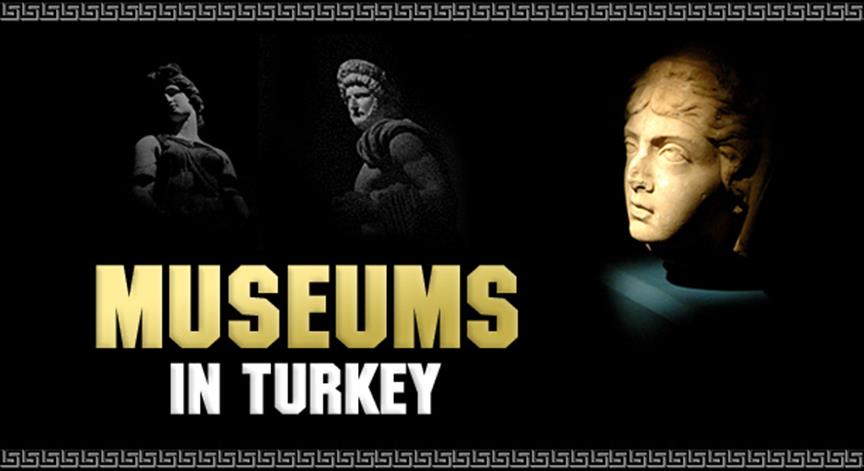

A great number of museums in Turkey display the wealth and history unearthed during the excavations carried out throughout the soils of Anatolia that has been a home for many different civilizations for thousands of years. Turkey's museums whose foundations were laid in the 19th century have taken a long way so far.
Fethi Ahmet Pasha opened the first museum in St. Irene (Aya Irini) Church in Istanbul in 1846. Grand Vizier Ali Pasha (1815-1871) re-arranged the museum and named it "Empire Museum". Irish Edward Goold was appointed as the head curator of the museum in 1869 and later, German P.A. Dethier succeeded him. The museum was later moved to Cinili Kosk (Tiled Kiosk).
In 1881, Osman Hamdi Bey was appointed as the head curator and a new era has started for Turkey's museums. A regulation was prepared and taking the historical goods abroad was banned. Osman Hamdi Bey constructed Istanbul Archeology Museum in the garden of Tiled Kiosk. Museums were also established in Konya in 1902 and in Bursa in 1904, during his period.
His brother Halil Ethem Bey was appointed as the head curator following Hamdi Bey's death in 1910. Ethem Bey contributed to the development of museums in Anatolia. Turkish Islamic Works (1914) and Old Eastern Works Museum in 1925 were established in Istanbul during his period.
ETI MUSEUM
Mustafa Kemal Ataturk, the Founder of the Republic of Turkey, who believed in the victory during the War of Indepence, gave the directives for establishment of an "Eti Museum" (Hittite Museum) in Ankara when the sound of blasts and cannons of fierce fighting between Greeks and Turks in the Batle of Sakarya could be heard from the city. The museum would lay the foundation of the Museum of Anatolian Civilizations.
Ethnography Museum is the first building of the Republic constructed for serving as a museum. The museum was opened in May 25, 1928 with a ceremony attended by Afghan King Amanuallah Khan.
HISTORICAL ARTEFACTS COME BACK HOME
In the first years following the declaration of republic, efforts were underway to bring back the smuggled historical works of art to Turkey.
U.S. Consulate shipped the artifacts (stored in Izmir High School) unearthed during "Sardes" excavation to New York Metropolitan Museum before the Greek army left Izmir. After the Great Victory (August 30), Mustafa Kemal Ataturk gave directives to take back the artifacts, and they were brought back to Turkey in 1924.
Ataturk instructed the first government that took office on May 9, 1920, to collect the historical works of art and establish new museums. General Directorate of Ancient Artifacts and Museums was founded accordingly.
A circular was issued on November 5, 1922 calling on archeological and ethnographic works of art to be collected and new museums to be established. The government program dated August 14, 1923 included museum studies widely.
TOPKAPI PALACE AND HAGIA SOFIA (AYASOFYA) BECOME MUSEUMS
With the directives of Ataturk and Council of Ministers decision dated April 3, 1924, Topkapi Palace was converted to a museum and opened to visitors. Ataturk closely followed the works to turn the palace into a museum. The palace, covering an area of 700,000 squaremeters, had been the management center of the Ottoman Empire for 400 years, till to 1855.
In his last visit to the museum in 1934, Ataturk said America map of Piri Reis that was in the library of the palace should not be kept secret and should be introduced to the world. He particularly wanted the map to be sent to the United States.
While inspecting the restoration of Sultanahmet Mosque in 1929, Ataturk saw the dilapidated situation of Hagia Sophia, and asked this building to be turned into a museum and taken care of. Thus, the Hagia Sophia, which was used as a church for 911 years and as a mosque for 481 years, started to serve as museum. It is one of the museums attracting biggest number of visitors since then.
Ataturk who led the establishment of Turkey's first museum of painting and sculpture in Istanbul, visited many museums and archeological sites and personally interested in establishment of many museums.
On the 10th anniversary of the foundation of the Republic, Ataturk ordered excavations to be carried out formally. Ataturk particularly wanted the Hittite civilization to be examined. Gavurkale (1930), Ahlatlıbel (1933), Karalar (1933), Cankırıkapı/Roman Bath, Etiyokusu, (1937), Alacahoyuk (1934), Pazarlı and Buyuk Gullucek (1934) were excavated. Surface research of Hasankeyf that started in 1932 was also among many archelogocial studies initiated with the directives of Ataturk. First acheologists, historians, philologists, art historians and anthropologists of young Republic of Turkey took part in the excavations that started all over Turkey, especially Canakkale-Troy, Corum-Bogazkoy, and Malatya-Aslantepe.
Ataturk who visited Berlin Museum and Pastdam Palace told Tahsin Oz, Director of Topkapi Palace Museum, that he was very impressed when he saw the Zeus Altar of Bergama but very saddened when he learned that it was smuggled from Turkey. It was also Ataturk who instructed for restoration of Aspendos Theater constructed during the period of Emperor Marcus Aurelius (A.D. 161-180) and opening it as a venue for cultural activities.
Historical building were used in general for the first museums of the Republic with the aim of maintenance and protection of such buildings.
Below are the museums opened during the period of Ataturk:
• Ankara Anatolian Civilizations Museum (1921)
• Antalya Museum (1922)
• Sivas Museum (1923)
• Adana Museum, Bergama Museum, Topkapı Palace Museum (1924)
• Izmir Museum, Edirne Museum, Izmir Museum, Ethography Museum (1925)
• Tokat Museum, Konya Museum, Amasya Museum (1926)
• Kayseri Museum (1929)
• Efes Museum (1930)
• Afyon Museum (1931)
• Sinop Museum, Van Museum(1932)
• Ayasofya Museum, Diyarbakır Museum(1934)
• Manisa Museum, Tire Museum (1935)
• Canakkale Museum, Nigde Museum, Tire Museum (1936)
• Istanbul Museum of Painting and Sculpture (1937).
It is possible to see the traces of first civilizations on earth in Anatolia. These lands bear the marks of civilizations extending from the prehistoric times to Hittites, from the Phrygians to Urartians, and from the Likians to Seljuks and Ottomans.
The museums in Turkey of where almost every single part has been a home for a different ancient city exhibit the traces of those civilizations some of which are long dead.
Here are the museums in Turkey:









